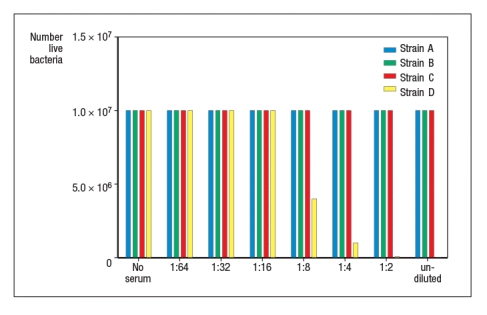Four different clinical isolates of the Gram-positive bacterium, Staphylococcus aureus, are tested for their abilities to resist innate immune defense mechanisms. For these experiments, each bacterial strain is first grown in culture to achieve log-phase replication, and then cultures are supplemented with dilutions of human serum containing normal serum proteins as well as antibodies capable of binding to S. aureus. One hour later, the cultures are analyzed and the numbers of live bacteria are quantitated. The data from this experiment are shown in Figure .
a) From these data, what general conclusions can be reached about the four strains of S. aureus?
To identify the bactericidal mechanisms killing each strain of S. aureus, the serum is depleted of complement C3 by running it over an anti-complement C3 antibody affinity column. The experiment above is then repeated and the data are shown in Figure .
b) What is the most likely mechanism accounting for the killing of strain D in this experiment?
To determine whether strains A and C are susceptible to the same microbicidal pathway, the serum is depleted of antibody by running over an anti-human immunoglobulin affinity column. Following this treatment, it is found that strain A, but not strain C is still killed by incubation with the serum.
c) From these data, what is the most likely mechanism killing S. aureus strain A? What about strain C?
Correct Answer:
Verified
View Answer
Unlock this answer now
Get Access to more Verified Answers free of charge
Q18: Our environment contains masses of microorganisms, many
Q19: Mannose binding lectins (MBL) and ficolins are
Q20: The alternative pathway of complement activation has
Q21: Pseudomonas aeruginosa is a Gram-negative bacterium that
Q22: Although homozygous deficiencies in complement regulatory proteins
Q24: Recent studies using mouse models of pulmonary
Q25: Even when the complement cascade fails to
Q26: The C3 convertase amplifies the process of
Q27: In vertebrates, complement activation generally involves a
Q28: Several pathogens produce proteins, either membrane-bound or
Unlock this Answer For Free Now!
View this answer and more for free by performing one of the following actions

Scan the QR code to install the App and get 2 free unlocks

Unlock quizzes for free by uploading documents